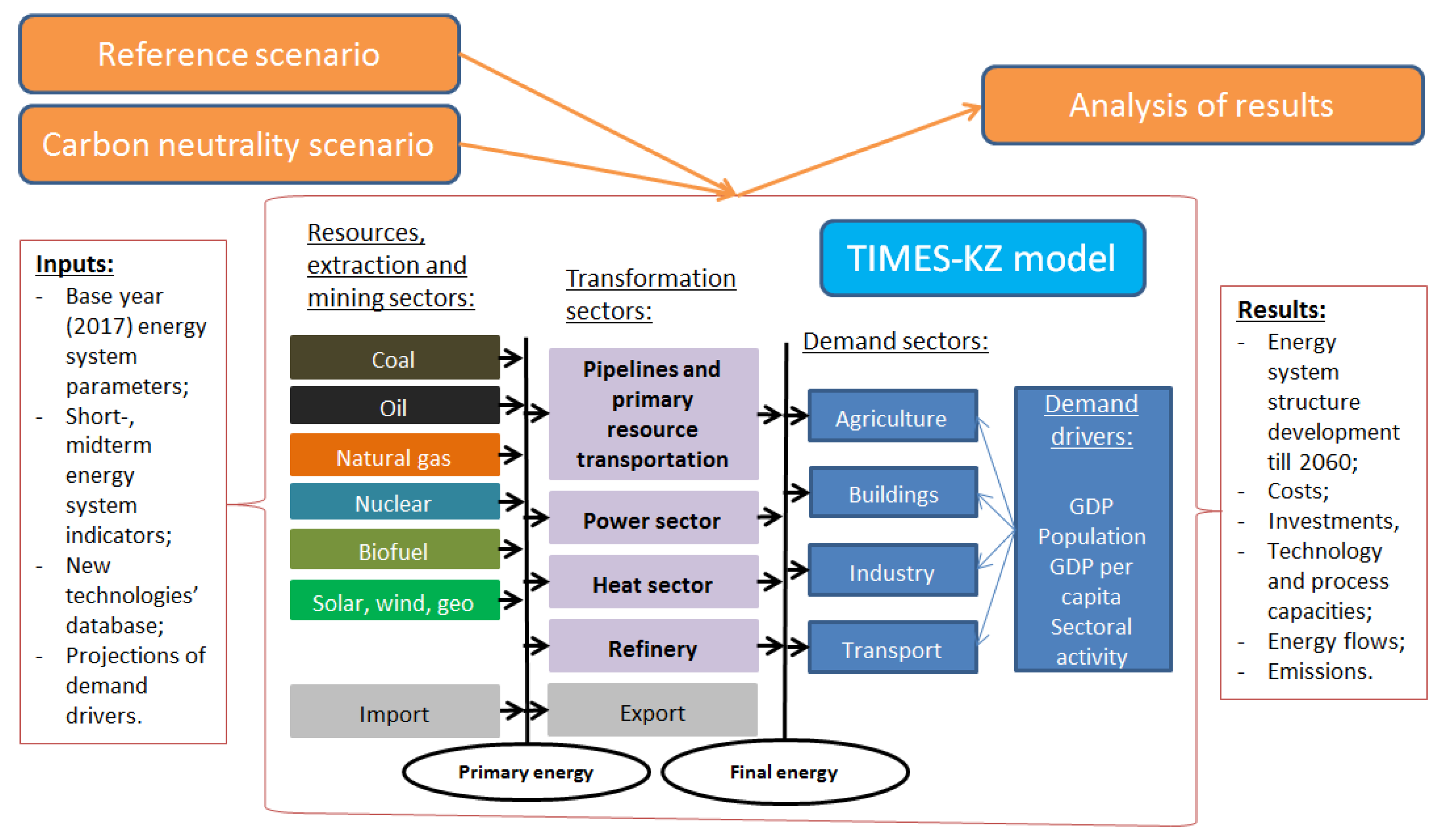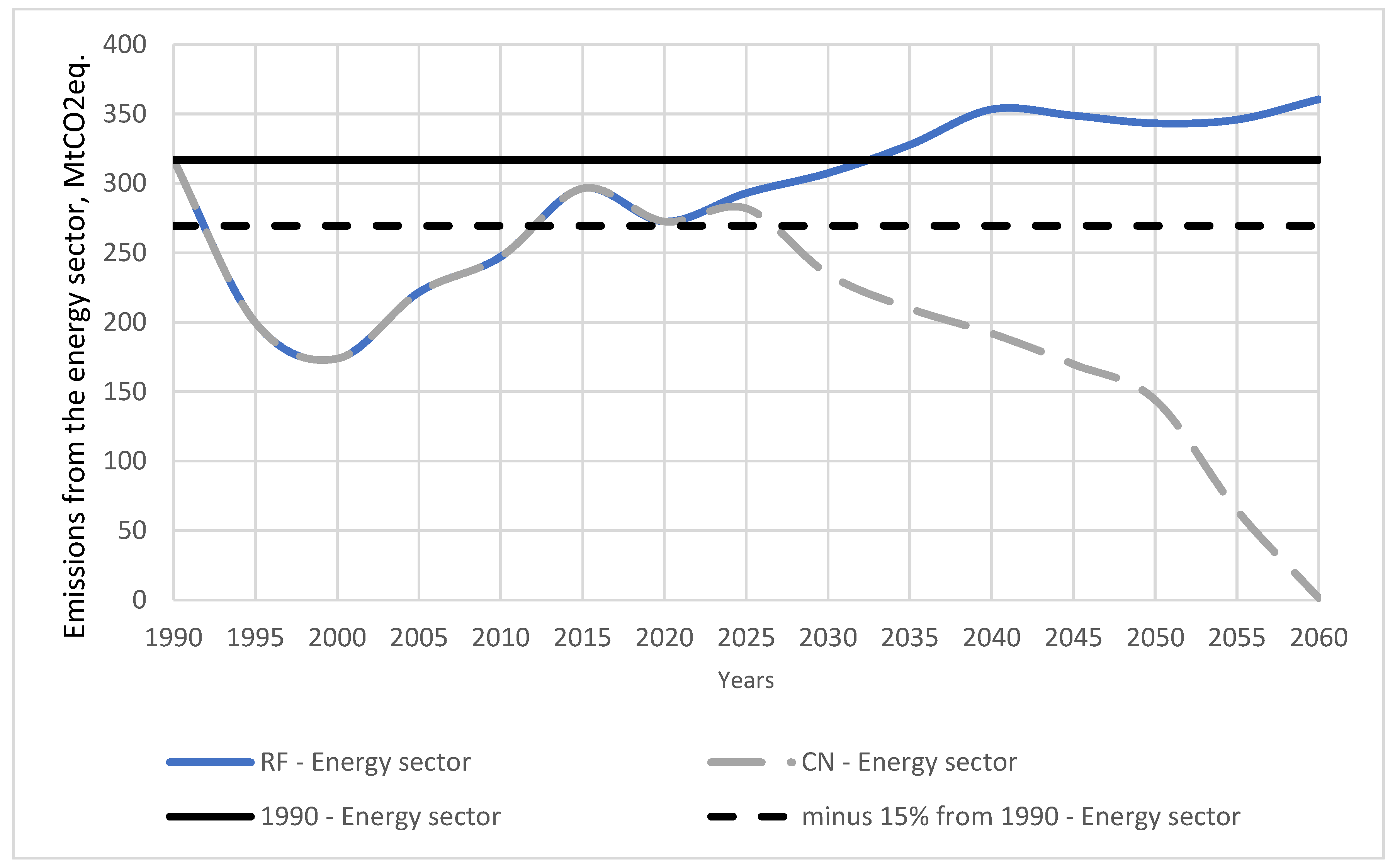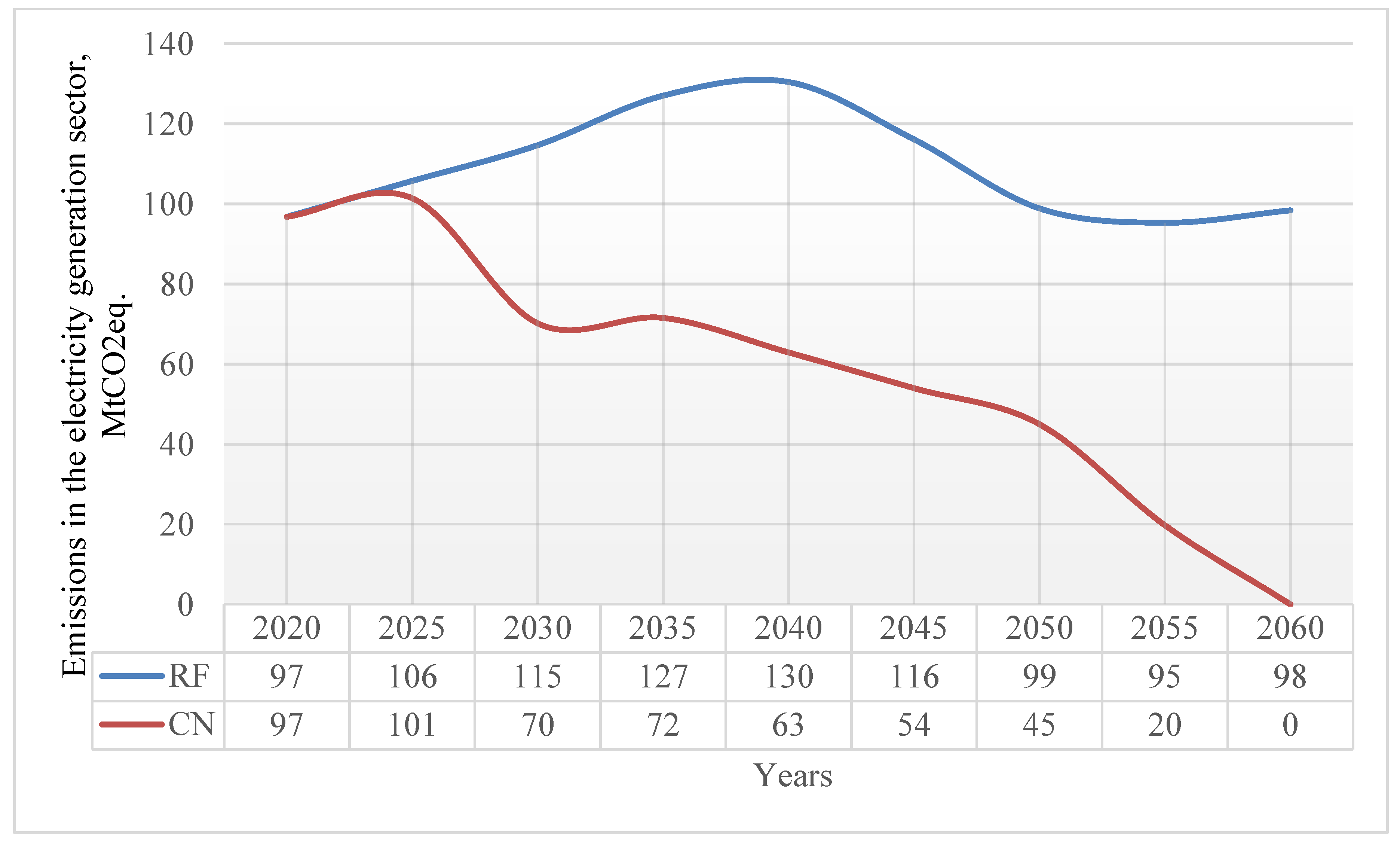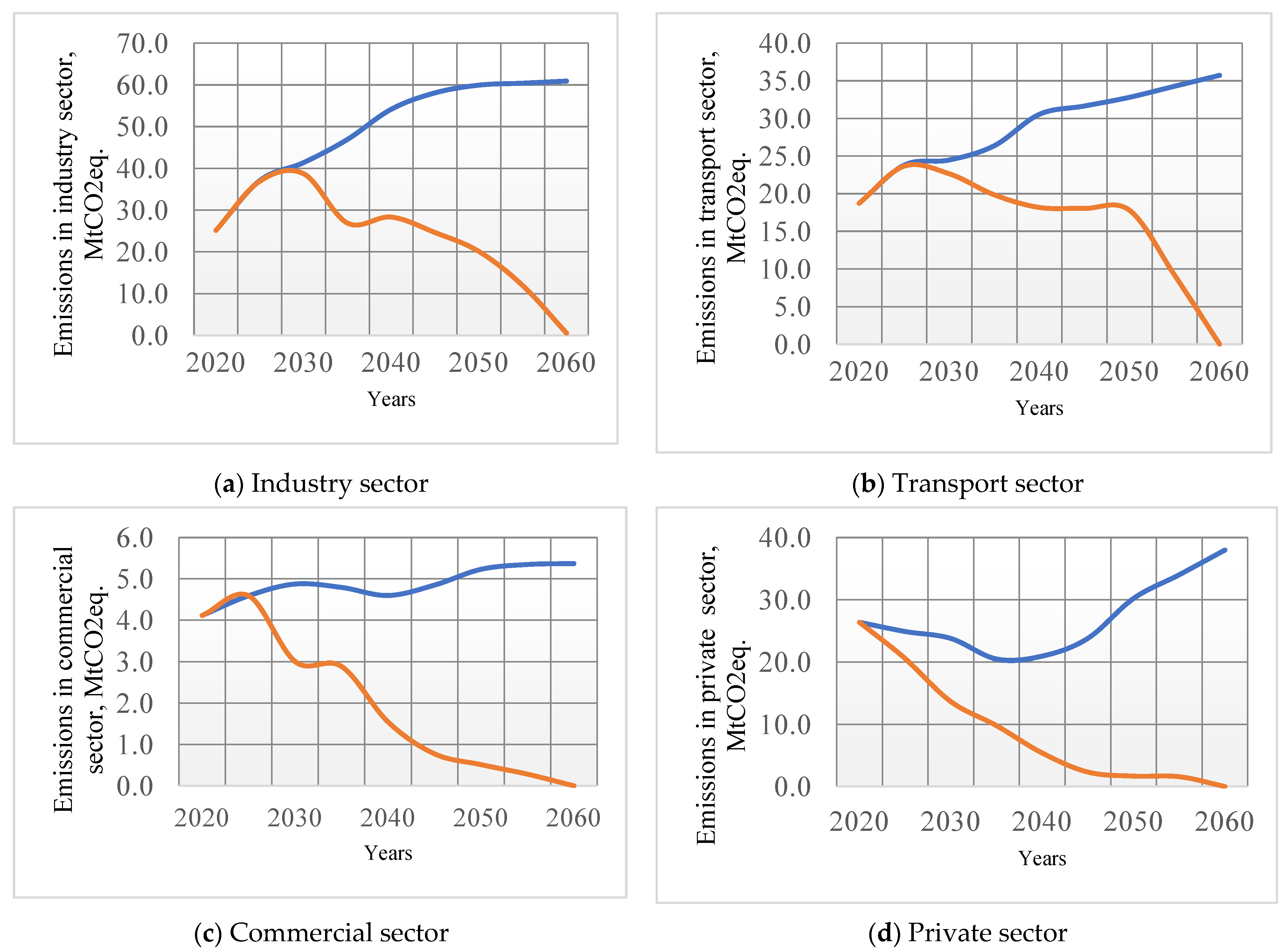Optimization Modelling of the Decarbonization Scenario of the Total Energy System of Kazakhstan until 2060
Abstract
:1. Introduction
- —
- A critical literature review on carbon neutrality and low-carbon development strategies is conducted, focusing specifically on Kazakhstan’s energy system.
- —
- A comprehensive analysis of the challenges and potential solutions unique to Kazakhstan’s energy infrastructure is provided, considering the country’s distinct climatological and geological conditions.
- —
- The impact of different assumptions on the future energy outlook of Kazakhstan is investigated, contributing to a better understanding of the country’s transition towards a low-carbon economy.
- —
- The existing gap in the literature is identified and addressed, offering valuable insights for policymakers, industry stakeholders, and researchers working on carbon neutrality and low-carbon development.
2. Research Methods and Assumptions
- Reference scenario without long-term GHG decreasing measures until 2060 (RF);
- The scenario of carbon neutrality until 2060 (CN).
3. Results and Discussion
3.1. The Current Policy and Measures against Climate Change in Kazakhstan
3.2. The Results of the Scenarios
3.3. The Electricity Generation Sector
3.4. Other Sectors
4. Conclusions
Author Contributions
Funding
Data Availability Statement
Conflicts of Interest
Abbreviations
| CN | carbon neutrality |
| GHG | greenhouse gas |
| LEDS | Low-Emission Development Strategy |
| EAF | electric arc furnace |
| ETS | emission trading system |
| ETSAP | Energy Technology Systems Analysis Programme) |
| HPP | Hydro Power Plant |
| IEA | International Energy Agency |
| FCCC | Framework Convention on Climate Change |
| IPCC | the Intergovernmental Panel on Climate Change |
| MEGNR | The Ministry of Ecology, Geology and Natural Resources |
| RES | renewable energy sources |
| RF | Reference scenario |
| SED RK | Socio-Economic Development of the Republic of Kazakhstan |
| UN | United Nations |
| CO2 | carbon dioxide |
| tCO2eq | tons of CO2 equivalent |
References
- Bernath, C.; Deac, G.; Sensfuß, F. Impact of sector coupling on the market value of renewable energies–A model-based scenario analysis. Appl. Energy 2021, 281, 115985. [Google Scholar] [CrossRef]
- Khosravi, F.; Jha-Thakur, U. Managing uncertainties through scenario analysis in strategic environmental assessment. J. Environ. Plan. Manag. 2019, 62, 979–1000. [Google Scholar] [CrossRef]
- Frister, M. What Informal Communication about the Energy Transition Tells us: To What Extent do Professionals in the Renewable Energy Sector Act as Change Agents in this Socio-Technical Process? Bachelor’s Thesis, University of Twente, Enschede, The Netherlands, 1 July 2022. [Google Scholar]
- Pauliuk, S.; Heeren, N. Material efficiency and contribution to climate change mitigation in Germany: A deep decarbonization scenario analysis until 2060. J. Ind. Ecol. 2021, 25, 479–493. [Google Scholar] [CrossRef]
- Żuk, P.; Żuk, P. National energy security or acceleration of transition? Energy policy after the war in Ukraine. Joule 2022, 6, 709–712. [Google Scholar] [CrossRef]
- Padmanabhan, R.; Abed, H.S.; Meskin, N.; Khattab, T.; Shraim, M.; Al-Hitmi, M.A. A review of mathematical model-based scenario analysis and interventions for COVID-19. Comput. Methods Programs Biomed. 2021, 209, 106301. [Google Scholar] [CrossRef] [PubMed]
- Decree of the President of the Republic of Kazakhstan Dated 2 February 2023 No. 121 “On approval of the Strategy for Achieving Carbon Neutrality of the Republic of Kazakhstan until 2060”. Available online: https://legalacts.egov.kz/npa/view?id=14311815 (accessed on 10 February 2023).
- LEDS by DIW-ECON. Supporting Green Economy in Kazakhstan and Central Asia for Low Carbon Economic Development. Available online: https://diw-econ.de/en/publications/supporting-green-economy-in-kazakhstan-and-central-asia-for-low-carbon-economic-development-times-cge-sd/ (accessed on 10 February 2023).
- Swart, R.J.; Raskin, P.; Robinson, J. The problem of the future: Sustainability science and scenario analysis. Glob. Environ. Chang. 2004, 14, 137–146. [Google Scholar] [CrossRef]
- Höjer, M.; Ahlroth, S.; Dreborg, K.-H.; Ekvall, T.; Finnveden, G.; Hjelm, O.; Hochschorner, E.; Nilsson, M.; Palm, V. Scenarios in selected tools for environmental systems analysis. J. Clean. Prod. 2008, 16, 1958–1970. [Google Scholar] [CrossRef]
- Teng, F.; Xu, S.-Q. Definition of business as usual and its impacts on assessment of mitigation efforts. Adv. Clim. Chang. Res. 2012, 3, 212–219. [Google Scholar]
- IEA. ETSAP: Energy Systems Analysis. Available online: http://www.iea-etsap.org/workshop/japan_dec2016/ESTAP%20Workshop_IEEJ.pdf (accessed on 13 July 2022).
- BloombergNEF. New Energy Outlook 2020: BNEF. Available online: https://about.bnef.com/new-energy-outlook-2020/ (accessed on 13 July 2022).
- IEEJ. The Institute of Energy Economics, Japan. Available online: https://eneken.ieej.or.jp/en/ (accessed on 10 February 2023).
- World Energy Model Documentation-Microsoft. Available online: https://iea.blob.core.windows.net/assets/932ea201-0972-4231-8d81-356300e9fc43/WEM_Documentation_WEO2021.pdf (accessed on 15 July 2022).
- Global Renewables Outlook: Energy Transformation 2050–Summary. Available online: https://www.irena.org/-/media/Files/IRENA/Agency/Publication/2020/Apr/IRENA_GRO_Summary_2020.pdf?la=en&hash=1F18E445B56228AF8C4893CAEF147ED0163A0E47 (accessed on 10 February 2023).
- IRENA. Available online: https://irena.org/publications/2021/Jun/World-Energy-Transitions-Outlook (accessed on 10 February 2023).
- Geco 2021. EU Science Hub. Available online: https://joint-research-centre.ec.europa.eu/geco-2021_en (accessed on 10 February 2023).
- Energy Outlook 2030-BP. Available online: https://www.bp.com/content/dam/bp/business-sites/en/global/corporate/pdfs/energy-economics/energy-outlook/bp-energy-outlook-2015.pdf (accessed on 17 July 2022).
- About Energy Perspectives. Equinor. Available online: https://www.equinor.com/sustainability/energy-perspectives (accessed on 10 February 2023).
- GECF. Gas Exporting Countries Forum. Available online: https://www.gecf.org/_resources/files/events/gecf-to-unveil-latest-edition-of-flagship-publication-global-gas-outlook-2050/2020-edition-of-the-gecf-global-gas-outlook-2050.pdf (accessed on 10 February 2023).
- GECF. Global Gas Outlook 2050. Available online: https://www.gecf.org/insights/global-gas-outlook?d=2022&p=1 (accessed on 10 February 2023).
- Keramidas, K.; Fosse, F.; Diaz-Vazquez, A.; Schade, B.; Tchung-Ming, S.; Weitzel, M.; Wojtowicz, K. Global Energy and Climate Outlook 2020: A New Normal Beyond COVID-19; Publications Office of the European Union: Luxembourg, 2021; Available online: https://publications.jrc.ec.europa.eu/repository/handle/JRC123203 (accessed on 10 February 2023).
- Equinor. Energy Perspectives 2020. Available online: https://www.equinor.com/content/dam/statoil/image/how-and-why/energy-perspectives/2020/energy-perspectives-report-2020-i.pdf (accessed on 10 February 2023).
- IEA. Net Zero by 2050–Analysis. Available online: https://www.iea.org/reports/net-zero-by-2050 (accessed on 10 February 2023).
- IEA. World Energy Outlook 2022–Analysis. Available online: https://www.iea.org/reports/world-energy-outlook-2022 (accessed on 10 February 2023).
- IPCC—Intergovernmental Panel on Climate Change. Available online: https://www.ipcc.ch/site/assets/uploads/sites/2/2019/06/SR15_Full_Report_High_Res.pdf (accessed on 10 February 2023).
- Media. McKinsey & Company. Available online: https://www.mckinsey.com/~/media/McKinsey/Industries/Oil%20and%20Gas/Our%20Insights/Global%20Energy%20Perspective%202021/Global-Energy-Perspective-2021-final.pdf (accessed on 10 February 2023).
- OPEC. World Oil Outlook. Available online: https://www.opec.org/opec_web/en/publications/340.htm (accessed on 20 July 2022).
- Zhakiyeva, S.; Gabbassov, M.; Akhmetbekov, Y.; Akybayeva, G.; Zhakiyev, N. The Development of a Risk Assessment Modeling for the Power System of Kazakhstan. In Proceedings of the 2021 IEEE International Conference on Smart Information Systems and Technologies (SIST), Astana, Kazakhstan, 28–30 April 2021; pp. 1–4. [Google Scholar]
- Amanbek, Y.; Kalakova, A.; Zhakiyeva, S.; Kayisli, K.; Zhakiyev, N.; Friedrich, D. Distribution Locational Marginal Price Based Transactive Energy Management in Distribution Systems with Smart Prosumers—A Multi-Agent Approach. Energies 2022, 15, 2404. [Google Scholar] [CrossRef]
- Kerimray, A.; Baigarin, K.; De Miglio, R.; Tosato, G. Climate change mitigation scenarios and policies and measures: The case of Kazakhstan. Clim. Policy 2016, 16, 332–352. [Google Scholar] [CrossRef]
- Di Leo, S.; Pietrapertosa, F.; Salvia, M.; Cosmi, C. Contribution of the Basilicata region to decarbonisation of the energy system: Results of a scenario analysis. Renew. Sustain. Energy Rev. 2021, 138, 110544. [Google Scholar] [CrossRef]
- De Miglio, R.; Akhmetbekov, Y.; Baigarin, K.; Bakdolotov, A.; Tosato, G. Cooperation benefits of Caspian countries in their energy sector development. Energy Strategy Rev. 2014, 4, 52–60. [Google Scholar] [CrossRef] [Green Version]
- Allena-Ozolina, S.; Pakere, I.; Jaunzems, D.; Blumberga, A.; Bazbauers, G. Integrated MARKAL-EFOM System (TIMES) model for energy sector modelling. In Proceedings of the 2020 IEEE 61th International Scientific Conference on Power and Electrical Engineering of Riga Technical University (RTUCON), Riga, Latvia, 5–7 November 2020; Available online: http://www.conference.rtu.lv/qazcdeTGBmjU/RTUCON2020_paper_99Ln97dW10Bi87.pdf (accessed on 25 May 2022).
- Perissi, I.; Martelloni, G.; Bardi, U.; Natalini, D.; Jones, A.; Nikolaev, A.; Eggler, L.; Baumann, M.; Samsó, R.; Solé, J. Cross-Validation of the MEDEAS Energy-Economy-Environment Model with the Integrated MARKAL-EFOM System (TIMES) and the Long-Range Energy Alternatives Planning System (LEAP). Sustainability 2021, 13, 1967. [Google Scholar] [CrossRef]
- Di Leo, S.; Caramuta, P.; Curci, P.; Cosmi, C. Regression analysis for energy demand projection: An application to TIMES-Basilicata and TIMES-Italy energy models. Energy 2020, 196, 117058. [Google Scholar] [CrossRef]
- Otarov, R.; Akhmetbekov, Y.; Zhakiyev, N. Determination of optimal CO2 allowance prices for stimulation of investments in CCS, RES and other carbon-clean technologies in Kazakhstan. In Sustainable Energy in Kazakhstan: Moving to Cleaner Energy in a Resource-Rich Country; Taylor and Francis: Milton Park, UK, 2017; pp. 123–133. [Google Scholar]
- Bakdolotov, A.; De Miglio, R.; Akhmetbekov, Y.; Baigarin, K. Techno-economic modelling to strategize energy exports in the Central Asian Caspian region. Heliyon 2017, 3, e00283. [Google Scholar] [CrossRef] [PubMed] [Green Version]
- Wyrwa, A.; Suwała, W.; Pluta, M.; Raczyński, M.; Zyśk, J.; Tokarski, S. A new approach for coupling the short-and long-term planning models to design a pathway to carbon neutrality in a coal-based power system. Energy 2022, 239, 122438. [Google Scholar] [CrossRef]
- Aliakbari Sani, S.; Maroufmashat, A.; Babonneau, F.; Bahn, O.; Delage, E.; Haurie, A.; Mousseau, N.; Vaillancourt, K. Energy Transition Pathways for Deep Decarbonization of the Greater Montreal Region: An Energy Optimization Framework. Energies 2022, 15, 3760. [Google Scholar] [CrossRef] [PubMed]
- Abdi, G.; Zhakiyev, N.; Toilybayeva, S. Decarbonisation Opportunities and Emerging Carbon Pricing Instruments in Central Asia. In Climate Change in Central Asia: Decarbonization, Energy Transition and Climate Policy; Springer Nature: Cham, Switzerland, 2023; pp. 51–65. [Google Scholar]
- Kerimray, A.; Suleimenov, B.; De Miglio, R.; Rojas-Solórzano, L.; Gallachóir, B.Ó. Long-term climate change mitigation in Kazakhstan in a post-Paris agreement context. In Limiting Global Warming to Well Below 2 °C: Energy System Modelling and Policy Development; Springer International Publishing: Cham, Switzerland, 2018; pp. 297–314. [Google Scholar]
- Gaeta, M.; Businge, C.N.; Gelmini, A. Achieving Net Zero Emissions in Italy by 2050: Challenges and Opportunities. Energies 2022, 15, 46. [Google Scholar] [CrossRef]




| Reference Scenario | References |
|---|---|
| Current policies scenario | IEA, 2021 [12] |
| OPEC’s reference or reference case | WOO, 2021 [13] |
| Reference case scenario (RCS) | GGO, 2021 [14] |
| Reference scenario (baseline scenario) | IEEJ, 2021 [15] |
| Rivalry—Equinor company | Equinor, 2021 [16] |
| Planned energy scenario (PES) | IRENA, 2021 [17] |
| CN | References |
| World energy outlook 2021 scenarios | [18] |
| IEA, 2021 |
| IEA, 2021 |
| IEA, 2021 |
| IEA, 2021 |
| Intergovernmental Panel on Climate Change, IPCC—Special Report on Global Warming of 1.5 °C | IPCC, 2021 [19] |
| 1.5 °C Scenario—IRENA (world energy transitions outlook 2021) | IRENA, 2021 [20] |
| Scenario 1.5 °C pathway | McKinsey, 2021 [21] |
| OPEC’s alternative scenarios (scenario A, scenario B) | World Oil Outlook, 2020 [22] |
| Carbon mitigation scenario (CMS) | GECF, 2021 [23] |
| Advanced technologies scenario | IEEJ, 2020 [24] |
| Renewal | Equinor, 2020 [25] |
| Rebalance | Equinor, 2020 [26] |
| Rapid transition scenario | BP Energy Outlook 2020 [27] |
| NEO climate scenarios (NCS) (green, gray, red) | BloombergNEF, 2021 [28] |
| New normal scenario | Global Energy and Climate Outlook, 2020 [29] |
| Reference Scenario (RF) | Carbon Neutrality (CN) Scenario | |
|---|---|---|
| General assumptions for all scenarios | ||
| GDP in the period 2022–2026 and until 2030 is forecasted to be at 4.0% per year, 3.5% per year until 2035, and around 3.0–2.0% after 2035 (Socio-Economic Development of the Republic of Kazakhstan (SED RK)). | V * | V |
| Population growth in the period 2022–2026 and until 2035 is expected to be in the range of 0.8–0.9% per year (according to the forecast of the Socio-Economic Development of the Republic of Kazakhstan (SED RK)). | V | V |
| Oil production rises to peak (115 million tons) in 2035. | V | V |
| Gasification of the country is proceeding according to the forecast gas balance of the Republic of Kazakhstan as a minimum and according to scenario assumptions as a maximum. | V | V |
| Scenario-specific assumptions | ||
| The share of electricity generation on natural gas is expected to be at the level of 20% and 25% in 2020 and 2030, respectively, and free from 2031. | X * | V |
| Share of electricity generation from RES at the level of 3%, 6%, and 15% in 2020, 2025 and 2030, respectively. | X | V |
| Share of coal production at 40% by 2030. | X | V |
| Carbon tax on non-quota sectors by the ETS, with an annual increase by 3 dollars starting from 2023 on buildings, agriculture, and transport. | X | V |
| Limits on GHG emissions for 2030 (minus 15% from 1990 level) and for 2060 (zero level). | X | V |
| Fact | Reference Scenario | CN | ||||||||||
|---|---|---|---|---|---|---|---|---|---|---|---|---|
| 2017 | 2020 | 2025 | 2030 | 2040 | 2050 | 2060 | 2025 | 2030 | 2040 | 2050 | 2060 | |
| Coal | 76.3 | 75.1 | 82.2 | 89.1 | 86.4 | 43.2 | 33.6 | 78.2 | 45.7 | 21.8 | 3.8 | 0.0 |
| Natural gas | 15.2 | 21.2 | 27.6 | 28.5 | 58.3 | 96.8 | 117.4 | 28.1 | 32.3 | 65.9 | 81.8 | 0.0 |
| HPPs are large | 11.2 | 9.1 | 11.2 | 11.2 | 13.3 | 13.3 | 7.4 | 11.2 | 13.3 | 13.3 | 13.3 | 7.4 |
| HPPs are small | 0.0 | 0.8 | 0.0 | 0.0 | 0.0 | 0.0 | 0.0 | 3.8 | 3.9 | 3.9 | 3.9 | 3.9 |
| Nuclear power | 0.0 | 0.0 | 0.0 | 0.0 | 0.0 | 0.0 | 0.0 | 0.0 | 12.9 | 21.5 | 65.5 | 228.6 |
| Solar | 0.0 | 1.3 | 1.0 | 1.0 | 5.4 | 35.1 | 57.7 | 1.9 | 6.9 | 13.8 | 32.8 | 112.8 |
| Wind | 0.3 | 1.1 | 0.8 | 0.8 | 1.8 | 9.5 | 10.0 | 1.8 | 8.7 | 17.3 | 38.5 | 119.3 |
| Bioenergy | 0.0 | 0.0 | 0.0 | 0.7 | 0.0 | 0.0 | 0.0 | 0.0 | 0.0 | 0.0 | 0.0 | 0.0 |
| Hydrogen | 0.0 | 0.0 | 0.0 | 0.0 | 0.0 | 0.0 | 0.0 | 0.0 | 3.2 | 13.4 | 11.0 | 0.0 |
| Total | 103.0 | 108.6 | 122.8 | 131.3 | 165.1 | 197.7 | 226.2 | 125.0 | 126.8 | 170.9 | 250.4 | 472.0 |
Disclaimer/Publisher’s Note: The statements, opinions and data contained in all publications are solely those of the individual author(s) and contributor(s) and not of MDPI and/or the editor(s). MDPI and/or the editor(s) disclaim responsibility for any injury to people or property resulting from any ideas, methods, instructions or products referred to in the content. |
© 2023 by the authors. Licensee MDPI, Basel, Switzerland. This article is an open access article distributed under the terms and conditions of the Creative Commons Attribution (CC BY) license (https://creativecommons.org/licenses/by/4.0/).
Share and Cite
Zhakiyev, N.; Khamzina, A.; Zhakiyeva, S.; De Miglio, R.; Bakdolotov, A.; Cosmi, C. Optimization Modelling of the Decarbonization Scenario of the Total Energy System of Kazakhstan until 2060. Energies 2023, 16, 5142. https://doi.org/10.3390/en16135142
Zhakiyev N, Khamzina A, Zhakiyeva S, De Miglio R, Bakdolotov A, Cosmi C. Optimization Modelling of the Decarbonization Scenario of the Total Energy System of Kazakhstan until 2060. Energies. 2023; 16(13):5142. https://doi.org/10.3390/en16135142
Chicago/Turabian StyleZhakiyev, Nurkhat, Ayagoz Khamzina, Svetlana Zhakiyeva, Rocco De Miglio, Aidyn Bakdolotov, and Carmelina Cosmi. 2023. "Optimization Modelling of the Decarbonization Scenario of the Total Energy System of Kazakhstan until 2060" Energies 16, no. 13: 5142. https://doi.org/10.3390/en16135142







